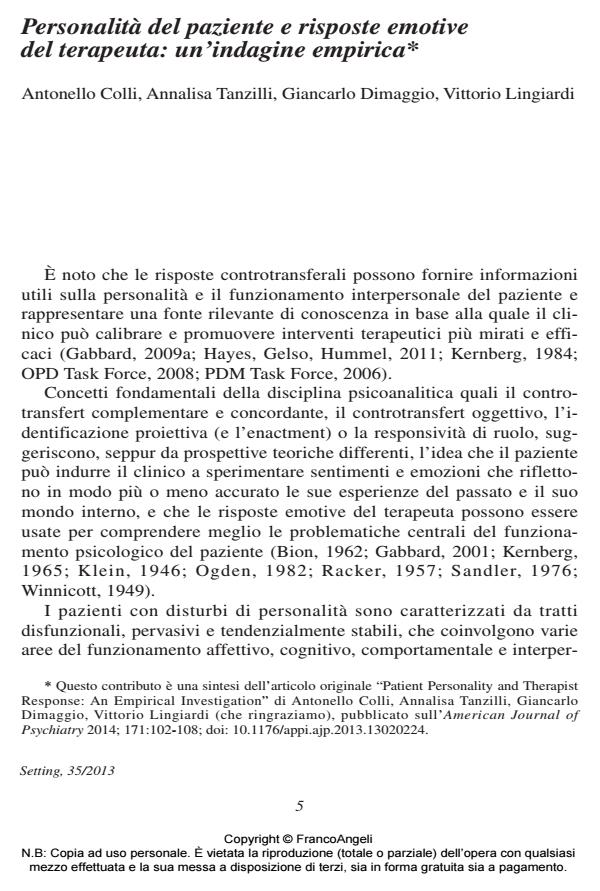Personalità del paziente e risposte emotive del terapeuta: un’indagine empirica
Titolo Rivista SETTING
Autori/Curatori Antonello Colli, Annalisa Tanzilli, Giancarlo Dimaggio, Vittorio Lingiardi
Anno di pubblicazione 2014 Fascicolo 2013/35
Lingua Italiano Numero pagine 9 P. 5-13 Dimensione file 69 KB
DOI 10.3280/SET2013-035001
Il DOI è il codice a barre della proprietà intellettuale: per saperne di più
clicca qui
Qui sotto puoi vedere in anteprima la prima pagina di questo articolo.
Se questo articolo ti interessa, lo puoi acquistare (e scaricare in formato pdf) seguendo le facili indicazioni per acquistare il download credit. Acquista Download Credits per scaricare questo Articolo in formato PDF

FrancoAngeli è membro della Publishers International Linking Association, Inc (PILA)associazione indipendente e non profit per facilitare (attraverso i servizi tecnologici implementati da CrossRef.org) l’accesso degli studiosi ai contenuti digitali nelle pubblicazioni professionali e scientifiche
L’articolo illustra i risultati di una ricerca sulla relazione tra la patologia di personalità e il livello di funzionamento psicologico del paziente e le risposte emotive del terapeuta. A un campione italiano casuale di 203 psichiatri e psicologi clinici (tra i quali, alcuni Soci dell’A.S.P.) è stato chiesto di compilare il "Therapist Response Questionnaire" (TRQ; Zittel Conklin, Westen, 2003), per identificare i pattern di risposta emotiva del terapeuta, e la Shedler-Westen Assessment Procedure 200 (SWAP-200; Westen, Shedler, 1999; Shedler, Westen, 2007; Shedler, Westen, Lingiardi, 2014) per valutare il disturbo di personalità ed il livello di funzionamento psicologico dei loro pazienti in trattamento. La ricerca ha dimostrato la correlazione significativa e specifica tra risposte del terapeuta e patologia del paziente (ad esempio, tra personalità borderline e i controtransfert sopraffatto/disorganizzato, impotente/inadeguato e speciale/ipercoinvolto, oppure tra personalità narcisistica e il controtransfert distaccato, ecc.). In generale, risulta che più forti sono i sentimenti negativi del terapeuta più basso è il funzionamento del paziente.
Antonello Colli, Annalisa Tanzilli, Giancarlo Dimaggio, Vittorio Lingiardi, Personalità del paziente e risposte emotive del terapeuta: un’indagine empirica in "SETTING" 35/2013, pp 5-13, DOI: 10.3280/SET2013-035001